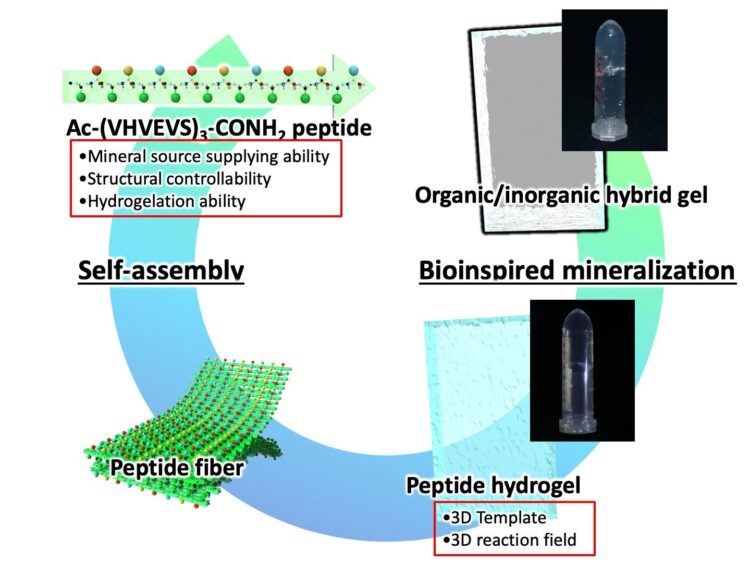A team of researchers developed a biomimetic mineralization of calcium carbonate using a multifunctional peptide template that can self-supply mineral sources, which in this case is a supply of carbonate ions, the precursor of calcium carbonate, and following the mechanism of biosynthesis of hard tissues by living organisms, called biomineralization, the ability to form hydrogels, which is modeled after the reaction environment of living organisms. Previous studies on mineralization have discussed the formation mechanism of inorganic crystals synthesized on templates with only a single function, such as a system supplying an external mineral source or a hydrogel system.
However, living organisms use their own enzymes to self-supply mineral sources and achieve control of the orientation, crystal phase, and morphology of inorganic crystals by using 3D assemblies with controlled structures as reaction fields. Therefore, elucidating the formation mechanism of inorganic crystals in a mineralization reaction environment that is closer to the biological environment such as the hierarchical hydrogel-like 3D assemblies in addition to the self-supply of mineral sources, is important for clarifying the true relationship for structural control between organic templates and inorganic materials that is achieved in biomineralization. It is important to clarify the true relationship for structural control between organic templates and inorganic materials achieved in biomineralization. The research group led by Assistant Professor Kazuki Murai of Shinshu University’s Department of Chemistry and Materials, Faculty of Textile Science and Technology was able to examine the nucleation and crystal growth mechanisms of calcium carbonate under conditions more similar to the biological environment through the self-supply of mineral sources through the expression of enzyme-like activities, and spontaneous formation of hydrogels, which is a model environment for cells. Therefore, the group’s findings will facilitate the understanding of the nucleation and crystal growth of inorganic crystals in biomineralization and the role of organic templates for crystal control.
Assistant Professor Kazuki Murai states, “the knowledge gained from this and other mineralization studies is the basis for revealing the amazing processes that organisms have acquired through evolution over a vast amount of time. We take our bones and teeth for granted in our daily life, but even they are not yet fully understood. I believe that the efforts of various researchers, including myself, will lead us to the “solutions” that have been acquired by living organisms over billions of years. I will be happy if my research can be a “stepping stone to unexpected inspiration and discovery.”
This study was able to clarify three major points, that a single peptide molecule has the ability to self-supply minerals through enzyme-like activity, the ability to control the crystal phase and morphology of inorganic materials, and the ability to spontaneously form hydrogels. The group was able to investigate the nucleation and crystal growth mechanisms of calcium carbonate using it as a template for mineralization. This research strategy to mimic the reaction environment of living organisms will be a breakthrough for previously unknown or unclarifiable events.
The team of researchers hopes to fully elucidate the formation and growth mechanisms of inorganic crystals, in addition to the structural control factors that occur between organic templates and inorganic materials in biomineralization. However, there are many obstacles in acquiring these findings, including the need for a great deal of research knowledge and far reaching collaboration of researchers belonging to various academic fields.
The group is currently working on developing inorganic materials that are crucial in the engineering and medical fields by using a material synthesis method that is clean and gentle on the environment, as well as elucidating the nanostructure of the constructed materials, the complexation of organic and inorganic materials, and the clarification of the correlation between structure and function of such materials.
###
Acknowledgments:
This research was supported by Japan Society for the Promotion of Science (JSPS) KAKENHI Grant Number JP16K18250 and 20K15340 and The Foundation for The Promotion of Ion Engineering.
Media Contact
Hitomi Thompson
[email protected]
Related Journal Article
http://dx.





